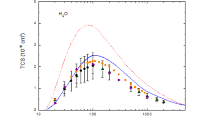Abstract
We have investigated the possibility of a link between the impact sensitivities of energetic compounds and the space available to their molecules in their crystal lattices. As a measure of this space, we use ΔV=Veff−V(0.002), where Veff is the effective molecular volume obtained from the crystal density and V(0.002) is that enclosed by the 0.002 au contour of the molecule’s gas phase electronic density, determined computationally. When experimental impact sensitivity was plotted against ΔV for a series of 20 compounds, the nitramines formed a separate group showing little dependence upon ΔV. Their impact sensitivities correlate well with an anomalous imbalance in the electrostatic potentials on their molecular surfaces, which is characteristic of energetic compounds in general. The imbalance is symptomatic of the weakness of the N–NO2 bonds, caused by depletion of electronic charge. The impact sensitivities of non-nitramines, on the other hand, depend much more strongly upon ΔV, and can be quite effectively related to it if an electrostatically-based correction term is included.

Measured impact sensitivities (h 50) plotted against computed ΔV for the compounds in Table 1. Triangles correspond to nitramines, circles to all others


Similar content being viewed by others
References
Iyer S, Slagg N (1988) In: Liebman JF, Greenberg A (eds) Structure and reactivity. VCH , New York ch 7
Storm CB, Stine JR, Kramer JF (1990) In: Bulusu SN (ed) Chemistry and physics of energetic materials. Kluwer, Dordrecht (The Netherlands) ch 27
Meyer R, Köhler J, Hornburg A (2007) Explosives, 6th edn. Wiley-VCH, Weinheim
Zeman S, Friedl Z, Koci J, Pelikan V, Majzlik J (2006) Centr Europ J Energ Mater 3(3):27–44
Zeman S, Friedl Z, Koci J (2007) Centr Europ J Energ Mater 4(4):23–31
Brill TB, James K (1993) Chem Rev 93:2667–2692
Rice BM, Hare JJ (2002) J Phys Chem A 106:1770–1783
Kamlet MJ (1976) Proc 6th Symp (Internat) Deton, Report No ACR 221, Office of Naval Research, p 312
Kamlet MJ, Adolph HG (1979) Propellants Explos 4:30–34
Politzer P, Murray JS (2003) In: Politzer P, Murray JS (eds) Energetic materials, part 2. Detonation, combustion. Elsevier, Amsterdam ch 1
Zeman S (2007) Struct Bond 125:195–271
Shackelford SA (2008) Centr Europ J Energ Mater 5(1):75–101
Politzer P, Murray JS, Concha MC, Lane P (2007) Centr Europ J Energ Mater 4(4):3–21
Politzer P, Murray JS (2009) Int J Quantum Chem 109:3–7
Politzer P, Murray JS, Lane P (2009) Int J Quantum Chem 109:534–539
Brill TB, Oyumi Y (1986) J Phys Chem 90:2679–2682
Oyumi Y, Brill TB (1988) Propellants Explos Pyrotech 13:69–73
Stewart PH, Jeffries JM, Zellweger JM, McMillen DF, Golden DM (1989) J Phys Chem 93:3557–3563
Politzer P, Murray JS, Lane P, Sjoberg P, Adolph HG (1991) Chem Phys Lett 181:78–82
Kohno Y, Maekawa K, Tsuchioka T, Hashizume T, Imamura A (1993) Chem Phys Lett 214:603–608
Kohno Y, Maekawa K, Tsuchioka T, Hashizume T, Imamura A (1994) Combust Flame 96:343–350
Kohno Y, Ueda K, Imamura A (1996) J Phys Chem 100:4701–4712
Oxley JC (2003) In: Politzer P, Murray JS (eds) Energetic materials, part 1. Decomposition, crystal and molecular properties. Elsevier, Amsterdam, ch 1
Murray JS, Concha MC, Politzer P (2009) Mol Phys 107:89–97
Storm CB, Ryan RR, Ritchie JP, Hall JH, Bachrach SM (1989) J Phys Chem 93:1000–1007
Politzer P, Grice ME, Seminario JM (1997) Int J Quantum Chem 61:389–392
Gindulyte A, Massa A, Huang L, Karle J (1999) J Phys Chem A 103:11045–11051
Murray JS, Lane P, Göbel M, Klapötke TM, Politzer P (2009) Theor Chem Acc, doi:10.1007/s00214-009-0620-2
Liu W-G, Zybin SV, Dasgupta S, Klapötke TM, Goddard WA III (2009) J Am Chem Soc 131:7490–7491
Murray JM, Lane P, Politzer P (1995) Mol Phys 85:1–8
Politzer P, Murray JS (1995) Mol Phys 86:251–255
Politzer P, Murray JS (1996) J Mol Struct 376:419–424
Murray JS, Lane P, Politzer P (1998) Mol Phys 93:187–194
Stewart RF (1979) Chem Phys Lett 65:335–342
Politzer P, Truhlar DG (eds) (1981) Chemical applications of atomic and molecular electrostatic potentials. Plenum, New York
Politzer P, Murray JS (2002) Theor Chem Acc 108:134–142
Politzer P, Murray JS (1998) Theochem 425:107–114
Politzer P, Murray JS (1999) Trends Chem Phys 7:157–165
Politzer P, Murray JS (2001) Fluid Phase Equilib 185:129–137
Bader RFW, Carroll MT, Cheeseman JR, Chang C (1987) J Am Chem Soc 109:7968–7979
Murray JS, Lane P, Politzer P (2009) J Mol Model 15:723–729
Qiu L, Xiao H, Gong X, Ju X, Zhu W (2007) J Hazard Mater 141:280–288
Rice BM, Hare JJ, Byrd EFC (2007) J Phys Chem A 111:10874–10879
Politzer P, Martinez J, Murray JS, Concha MC, Toro-Labbé A (2009) Mol Phys, doi:10.1080/00268970903156306
Hintze J (2006) NCSS, Kaysville, UT, www.ncss.com
Zhang C, Shu Y, Huang Y, Zhao X, Dong H (2005) J Phys Chem B 109:8978–8982
Acknowledgments
MP and PV acknowledge the support of this work by the Ministry of Education, Youth and Sports of the Czech Republic as a part of its research projects Nos. MSM0021620835 (MP) and MSM0021627501 (PV), respectively. PP, JSM and MCC appreciate the support of the Defense Threat Reduction Agency, Contract No. HDTRA1-07-1-0002, Project Officer Dr. William Wilson.
Author information
Authors and Affiliations
Corresponding author
Rights and permissions
About this article
Cite this article
Pospíšil, M., Vávra, P., Concha, M.C. et al. A possible crystal volume factor in the impact sensitivities of some energetic compounds. J Mol Model 16, 895–901 (2010). https://doi.org/10.1007/s00894-009-0587-x
Received:
Accepted:
Published:
Issue Date:
DOI: https://doi.org/10.1007/s00894-009-0587-x




